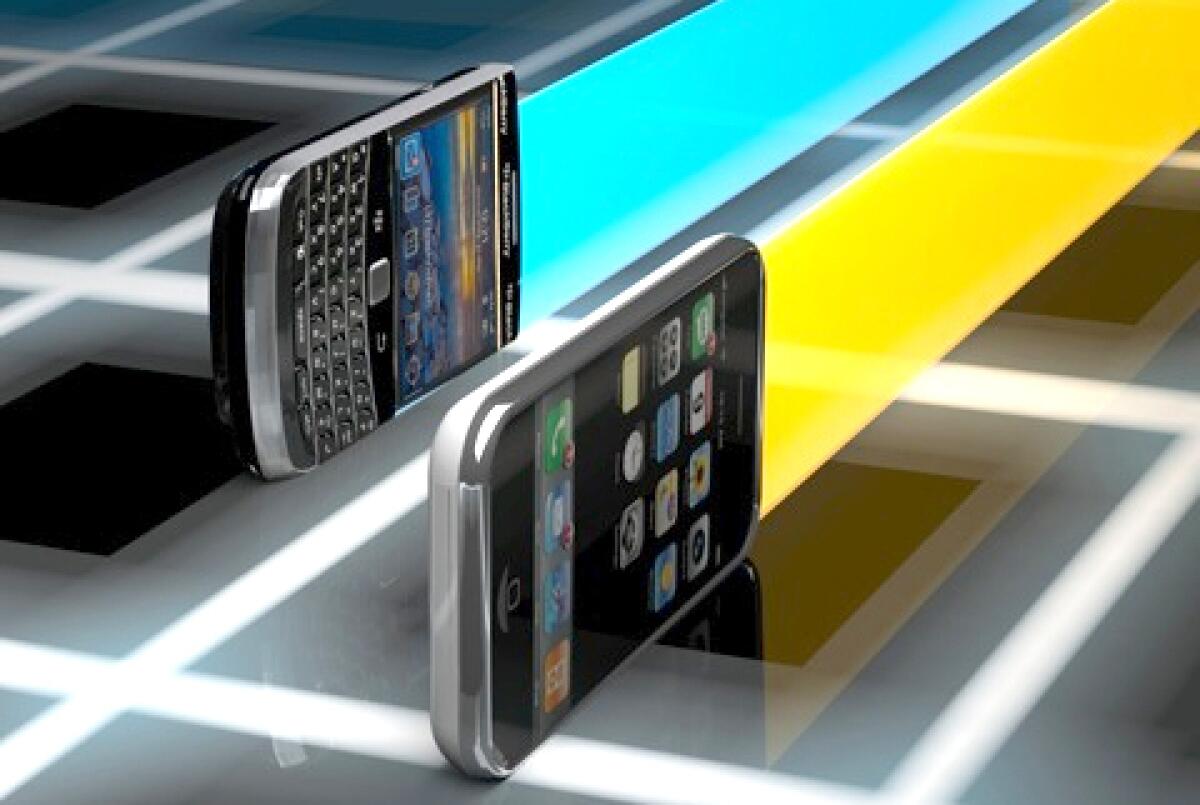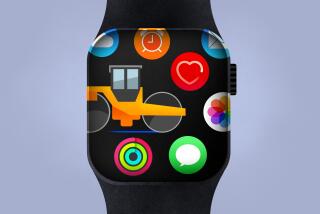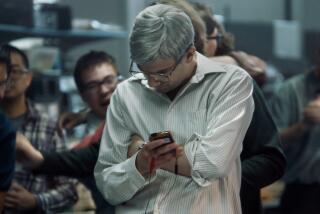BlackBerry vs. iPhone: What’s in your pocket?

- Share via
There was a time when BlackBerrys grew wild.
They were everywhere: boardrooms, restaurants and kitchen tables. The dark little devices would vibrate every time a new e-mail arrived, delivering a tiny thrill that millions of employees came to both loathe and desire. It wasn’t long before the device earned its enduring nickname: CrackBerry.
The famously addictive device popularized e-mail on the go and turned its Canadian maker, Research in Motion Inc., into a $34-billion company and the business world’s leading supplier of smart phones. It has 41 million users worldwide, and BlackBerrys represent more than half of all corporate smart phone users in the U.S., according to research firm ComScore Inc.
But now Apple Inc., the company that upended the music industry with its iPod and then the cellphone market with its iPhone, wants to gobble up a slice of BlackBerry’s multibillion-dollar pie.
In September, after only three years on the market, the iPhone for the first time surpassed the BlackBerry in total quarterly sales with 14.1 million devices sold, compared with 12.1 million for Research in Motion, or RIM, as it is commonly known.
In its quest to become the de facto smart phone maker for business users — the company has already won about 23% of that market, ComScore said — Apple has hired a number of former RIM salespeople to help it sell its phones to corporate America.
Apple says the iPhone is more than a mere appliance for sending e-mail. The device, with its sleek touch screen and ability to run hundreds of thousands of Web-connected applications, games and utilities, can be used for nearly any purpose, business or personal, a line that Apple hopes to blur out of existence.
“Most people now want to use a single device to handle both their personal and professional lives,” said Shaw Wu, an analyst at Kaufman Bros. “That’s what Apple’s really good at — and now RIM is playing catch-up.”
For its part, RIM has begun appealing to consumers with an array of flashier, user-friendly devices. Newer models such as the Torch boast both an iPhone-like touch screen and a physical keyboard for die-hard Blackberry users accustomed to rapidly tapping out e-mail messages.
The company has also created an online app store, called App World, though it has only about 15,000 apps compared with Apple’s 300,000.
RIM officials declined to be interviewed for this report.
For decades Apple has been the specialist in consumer electronics, with its iPod music player and Macintosh personal computers. It has never been more than a niche player in the corporate market.
Lately, though, the Cupertino, Calif., company is putting forth a novel argument: When it comes to smart phones and tablet computers, the distinction between a home and office device is becoming less necessary.
“We’re not developing two different lines like many companies do with enterprise versions and consumer versions,” Apple’s chief operating officer, Tim Cook, said in an October conference call with investors. “This is another part of our simplistic approach to things that I think will pay us great dividends, and it’s already starting to do so.”
Apple says that 80% of Fortune 500 companies are trying out the iPhone to varying degrees, including General Electric Co., Procter & Gamble Co., Allstate Corp. and Pfizer Inc., though many of those are trials that involve small numbers of users.
Last year, drug maker Sanofi-Aventis gave iPhones and iPad tablet computers to 1,500 employees across the company and said it planned to continue moving employees to Apple’s platform, giving workers the option of replacing their company-issued BlackBerrys.
With apps downloaded from Apple’s App Store, Sanofi employees can use iPhones or iPads to monitor live data “dashboards” about sales of particular drugs and the performance of marketing initiatives. They can watch live Web presentations by colleagues, and they can communicate with groups of other employees via a company-specific social network called Yammer.
“True mobility is now kicking in,” said Vic Rupinder, a senior technology manager at Sanofi. “You’re no longer tied to your desktop, so you can do work while you’re moving around.”
San Francisco software maker Salesforce.com Inc. broke from standard corporate information technology practice this year: Instead of assigning smart phones to its 4,800 employees, it lets them bring their own. Under this new model — known as BYOD (Bring Your Own Device) — the employee buys the device and the employer pays the monthly voice and data bill.
That approach is catching on in the business community and has tended to favor Apple, which is already a favorite among consumers. At Salesforce, BlackBerry was the standard device before the new policy. Now 40% of the employees use iPhones while 60% still have BlackBerrys.
RehabCare Group Inc., a private nursing specialist in St. Louis, has given out more than 8,000 iPod Touch devices to its therapists. (The Touch is an iPhone without the cellular transmitter, but it can still perform most of the functions via a Wi-Fi Internet signal.)
Therapists use a custom app to record patients’ vital signs, treatments and other clinical information. Besides tracking a patient’s progress, the company can use the data to determine whether caregivers are working efficiently.
And when the therapists go home they’re free to use the device however they like — to play games, send text messages, watch video or listen to music.
“With laptops we’d tell people, ‘Don’t take it home, don’t let your kids play with it, don’t download anything to it,’ because as soon as they do it it’s going to break, and they’ll be calling the help desk the next day,” said Dick Escue, the company’s chief information officer.
“But now that we’ve adopted Apple, we tell people, ‘Please take it home and put all your music and photos and e-mail on it,’” he said. “And it turns out that as a result they’ll take better care of the device.”
At the same time it is evangelizing about the business uses of the iPhone, Apple is positioning the iPad as a second corporate must-have.
At Hyatt Hotels, managers use iPads to showcase their hotels when they meet with customers looking to book parties or special events. If a bride wants to see photos of previous weddings the hotel has hosted, the Hyatt employee can use an iPad to thumb through dozens of images as well
as videos and information sheets.
In earlier times hotel sales staffers had to choose a specific set of photos for each meeting, have them printed and then put them in a leather-bound photo album, said John Prusnick, Hyatt’s technology innovation director.
“Now they have a single, very light portable device that contains all of the images they could ever want,” he said. “The iPad just seems to translate the experience better and helps us sell our hotels in a much sharper way.”
Prusnick added that iPhones now account for 40% of Hyatt’s mobile devices and are quickly catching up to standard-issue BlackBerrys.
But even with Apple’s apparent advantage in hype and consumer popularity, the BlackBerry is “still the gold standard” for mobile smart phones, said Ashok Kumar, an analyst at Rodman & Renshaw.
Also, displacing an incumbent takes time, particularly in the slow-moving world of corporate IT. Companies are often contractually bound to telecommunications providers for long periods, and skittish about any major changes that could interfere with day-to-day operations.
“It’s not the kind of thing that can happen overnight,” Kumar said. Giving employees a completely different kind of mobile device is “much more of an open- heart surgery.”
“So if it’s a sunset for RIM, it’s going to be a very long sunset.”
More to Read
Inside the business of entertainment
The Wide Shot brings you news, analysis and insights on everything from streaming wars to production — and what it all means for the future.
You may occasionally receive promotional content from the Los Angeles Times.










